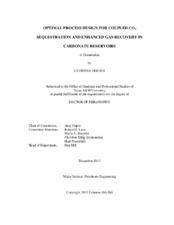Optimal Process Design for Coupled CO2 Sequestration and Enhanced Gas Recovery in Carbonate Reservoirs
Abstract
Increasing energy demand combined with public concern for the environment obligates the oil industry to supply oil and natural gas to the public while minimizing the carbon footprint due to its activities. Today, fossil fuels are essential in meeting the global energy needs, but have the undesirable outcome of producing carbon dioxide. Carbon dioxide (CO_(2)) injection in reservoirs is an appealing Enhanced Oil/Gas Recovery method for increasing hydrocarbon production by using the miscible interactions between hydrocarbon and carbon dioxide. Carbon dioxide flooding is beneficial to the environment and to petroleum producers, since it can store carbon dioxide while increasing oil and natural gas production. A practical challenge in combining CO_(2) Sequestration with Enhanced Gas Recovery (EGR) is determining the optimal process parameters that maximize the project value.
This research describes the development of a procedure to determine the best process conditions for the CO_(2) EGR and Sequestration process. Analysis includes experimental work that illustrates that CO2 is able to reduce the dew point pressure of wet gas fluids and that reservoir fluid phase changes can be indicated by changes in total fluid compressiblity. In addition, compositional simulation illustrates that CO_(2) improves condensate and natural gas recovery. Studies show that the ideal reservoir management strategy for CO_(2) EGR is to set the CO_(2) injectors’ bottom hole pressure to the initial reservoir pressure. An economic model is developed that illustrates the capital investment necessary for the CO_(2) EGR and Sequestration process for different capture technologies and levels of captured CO_(2) impurity. This economic model is utilized in conjunction with an optimization algorithm to illustrate the potential profitability of the CO_(2) EGR and Sequestration project. To illustrate the economic risk associated with CO_(2) EGR and Sequestration project, probabilistic analysis is used to illustrate scenarios where the technology is successful.
This work is applicable to carbonate wet gas reservoirs that have significant gas production problems associated with condensate blockage. This work is also useful in modeling the economics associated with CO_(2) EGR and CO_(2)Sequestration. The strategy developed in this work is applicable to designing process conditions that correspond to optimal CO_(2) EGR and optimal CO_(2) Sequestration.
Citation
Odi, Uchenna (2013). Optimal Process Design for Coupled CO2 Sequestration and Enhanced Gas Recovery in Carbonate Reservoirs. Doctoral dissertation, Texas A & M University. Available electronically from https : / /hdl .handle .net /1969 .1 /151726.


